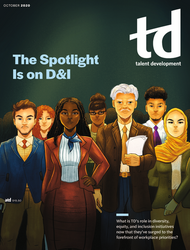TD Magazine Article
Become an Understanding, Empathetic Leader
A review of Saving Face: How to Preserve Dignity and Build Trust by Maya Hu-Chan
Thu Oct 01 2020
Saving Face: How to Preserve Dignity and Build Trust
By Maya Hu-Chan
Berrett-Koehler, 224 pp., $11.99
Saving Face surpasses Merriam-Webster's definition "to avoid having other people lose respect for oneself" and demolishes the widespread belief that it's only a cultural concept. Throughout the book, Hu-Chan echoes the origin and history of saving face in Asian culture and reiterates that it's more than simply avoiding embarrassment via different behaviors in a work environment—it's a representation of one's "self-esteem, identity, reputation, status, pride, and dignity."
The author dedicates the introduction to explaining the three components of face: honoring, losing, and saving. In subsequent chapters, she provides anecdotes, practical suggestions to reinforce learnings, and easy-to-follow models to use in the workplace and even homelife.
The heart of the book resides in the chapter "Authentic Acts of Saving and Honoring Face." Hu-Chan says to do so "requires a positive intention and understanding the other person's frame of reference without judgment." She gives poignant recommendations of how vocalizing intentions, using emotional intelligence, and promoting worthiness—to name a few—put saving face into action when interacting with others and can uplift employees while achieving results.
Hu-Chan also shares her story as an executive coach, teaching from firsthand experience that expressing genuine appreciation with key motivational strategies can retain employees while honoring face. Those lessons easily apply to relationships with co-workers, direct reports, mentees, and even problematic employees.
She likewise provides detailed, illustrative models with examples and supportive diagrams. The BUILD model (benevolence and accountability, understanding, interacting, learning, and deliver) targets people leaders but is applicable to project teams and departmental collaborators. The AAA model (aware, acquire, adapt) provides a toolkit for global leaders and team members for engaging with teams around the world to develop a business and cultural perspective to gain effective results.
This is a resourceful read for people leaders and cross-functional collaborators and would be beneficial to coaches, and HR and organization development professionals. Get ready to take notes and mark pages for future reference.

